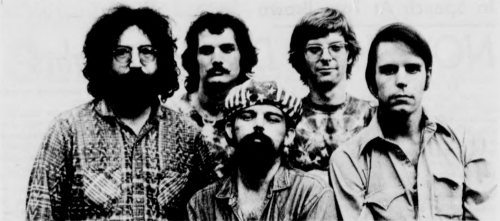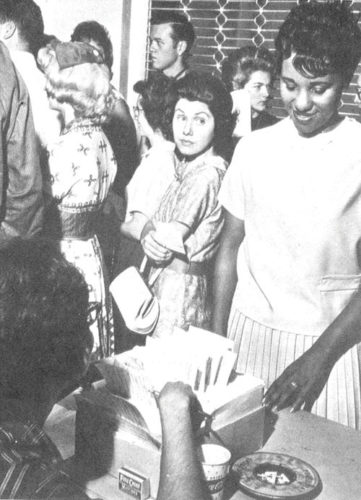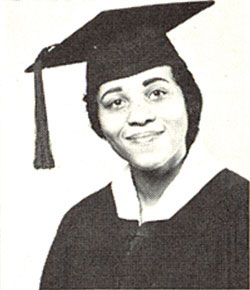Dead on
Leave a Comment
Jerry Garcia and the Grateful Dead played Daniel-Meyer Coliseum on Nov. 14, 1971. Rock music historians say that their TCU performance was seminal to the group becoming a touring band. Courtesy of TCU Archives
Goldilocks was a bigger role model than we give her credit for. Her steadfast pursuit of a harmonious “just right” condition stands as the definitive model for those seeking balance: something not too hot, not too lumpy, but just right.
Both musically and historically, TCU found itself — at least once — at an enviable fulcrum between fate and destiny when, on Nov. 14, 1971, the rock bands Grateful Dead and New Riders of the Purple Sage brought a divergent mix of communities together on campus. In Daniel-Meyer Coliseum, hippies and debutantes danced side by side with ROTC cadets and trust fund kids for an evening that bound cultures. Greater though, was that this show was among the nexus of concerts for both bands’ outward propulsion into national consciousness.
To some alumni, that may mean nothing. Many TCU students will have graduated without knowing anything about Saint Stephen with his rose, or Casey Jones and his train, or other Dead staples. The New Riders of the Purple Sage, who played with the Dead on the road for years, may have also escaped some students’ collections. But even those who never picked up the Dead’s “Skeletons in the Closet” or the Riders’ self-titled 1971 album should remain impressed that our own campus administration booked both bands during their ground breaking 1971 tour.
Those who recall campus life in the early ’70s won’t be surprised to know that the decision to hold a Grateful Dead event on campus was spiked like punch. But administrators at TCU that year found the give and take between authority and spontaneity to be just right.
First a little background: The university booked Jefferson Airplane to play at TCU in 1970, and turmoil ensued. Unrest was in the air in 1970 as a general result of coming after 1969, but Jefferson Airplane and front man Paul Kantner were especially good at stoking the fires. According to a November 1971 Skiff article “because of the abundance of marijuana, liquor and trash, concerts of that type are indefinitely banned on TCU’s campus. However, the Grateful Dead, also one of San Francisco rock pioneers, has been allowed on campus with the hope this year’s concert will lack the problems encountered last year.”
Thankfully the TCU brass bent to the student’s request. “I am giving the TCU students a second chance,” Libby Proffer, director of student services, told the Skiff. “If there are problems with this concert, there will not be a third chance.”
Luckily, nothing blew up. The show went off without a hitch.
The New Riders of the Purple Sage opened for the Dead, as they did for most of that 1971 tour and many Grateful Dead shows after. Few, if any, arrests occurred, and the evening was an enjoyable one by most accounts.
Buddy Cage, the New Riders’ world-renowned pedal steel guitar virtuoso, does not recall details about their set list at Daniel-Meyer Coliseum, but the TCU visit did jump out, partly because this was his first tour with the bands. “I had traveled the Southwest a lot when I was a kid, so I was fairly excited and a little nostalgic about playing Fort Worth,” he said.
Still, he had some reservations.
“What would a Christian school do with an atheist on campus? More seriously, the Dead were always viewed suspiciously in the South and Southwest due to drug laws around the time.” Any concerns he or the band had were put to rest, though, once the show started. “When we played at TCU, people were there to PAR-TAY!”
Cage recalled a nice, open vibe and great fan interaction.
“It was a fairly open scene, and with the co-mingling of the Homecoming campus crowd — all tuxed and gowned up — we were in for some serious boogie! I recall we played an exceptional night as the push and pull from the audience was utterly remarkable,” Cage said.
And so the concert would remain in the history books — more of an event than a memorable set list. Even Grateful Dead historian and publicist Dennis McNally, whose national bestselling history of the Grateful Dead, A Long Strange Trip: The Inside History of the Grateful Dead, did not reference much about the concert. But he suggested that the selection of the Dead to play was fortuitous based on the more peaceful demeanor of the band compared to that of Jefferson Airplane.
Garcia, McNally said, was always very respectful of the power that one held when in front of the microphone. Jefferson Airplane’s Kantner, who McNally described as “kind of a difficult, arrogant kind of guy,” was more prone to abuse the power and work the crowd into a frenzy.
“Jerry would be just the opposite. The idea of encouraging the audience to endanger somebody would be the furthest thing from his mind,” McNally said.
TCU was able to host an outstanding show, both for the students and for the bands. What should be memorable is that TCU took at least one more chance, however risky, to have both groups on campus in 1971. Just as NASA was launching rockets into outer space with great aplomb, both bands skyrocketed to new success as a result of that tour, the third date of which was played at TCU.
The Grateful Dead, of course, grew to become one of the history’s largest musical touring sensations. They have toured since the 1995 death of Garcia, as recently as this spring and summer. The New Riders of the Purple Sage released their new album “Where I Come From” in June of ’09, with seven of 12 tracks co-written by Grateful Dead lyricist Robert Hunter.
For fans of the genre and the bands, the New Riders still come through Texas on occasion, playing Austin and in Dallas — most recently at Dallas’ Granada Theater in 2008. But from the Grateful Dead’s touring history, it deserves mention that of the few shows that came through Texas, TCU was able to nab one.
To hear the Daniel-Meyer Coliseum Grateful Dead show, click the play button on the embedded file below or check out www.tinyurl.com/yabjoha. Or search archive.org
under “Grateful Dead Fort Worth.” No searches were able to generate a
recording of the New Riders’ show from that day, but as any taper will
tell you, the search for the show is often half of the fun.
Nov. 14, 1971 set list
Bertha
Beat It On Down the Line
China Cat Sunflower
I Know You Rider
El Paso
Sugaree
Jack Straw
Big Railroad Blues
Me and Bobby McGee
Loser
Playing in the Band
Tennessee Jed
You Win Again
Mexicali Blues
Casey Jones
One More Saturday Night
Truckin’
Drums
The Other One
Me and My Uncle
Wharf Rat
Sugar Magnolia
Johnny B. Goode
To listen to the playlist, go to www.tinyurl.com/yabjoha.



 Anything for Thanksgiving
Anything for Thanksgiving Culture Without Accountability: What’s the Fix?
Culture Without Accountability: What’s the Fix? New from TCU Press
New from TCU Press But eventually you were able to locate them? Yes, randomly one day I had gone back to look at a database about archival materials, reinserted her name to just check again, and all of a sudden this collection came up at a place called the Congregational Library in Boston, which is affiliated with the missionary organization. It said there were 25 items pertaining to Catharine Brown in the archive there. So I got in touch with the librarian immediately and those were the 25 original source items I had been looking for. The reason I found that one record after I had already searched multiple times in that same database is they had just found it, they had just entered it into the database. So, actually the timing for me was fortuitous because the book wasn’t finished yet. The librarians were really cooperative and helpful to me, and I was able to incorporate that material. So it’s a very haphazard process. It’s a combination of digging through old papers in a very old-fashioned way and the new-fashioned technologies, which allow you to be much more comprehensive than you would have been able to be 30 years ago.
But eventually you were able to locate them? Yes, randomly one day I had gone back to look at a database about archival materials, reinserted her name to just check again, and all of a sudden this collection came up at a place called the Congregational Library in Boston, which is affiliated with the missionary organization. It said there were 25 items pertaining to Catharine Brown in the archive there. So I got in touch with the librarian immediately and those were the 25 original source items I had been looking for. The reason I found that one record after I had already searched multiple times in that same database is they had just found it, they had just entered it into the database. So, actually the timing for me was fortuitous because the book wasn’t finished yet. The librarians were really cooperative and helpful to me, and I was able to incorporate that material. So it’s a very haphazard process. It’s a combination of digging through old papers in a very old-fashioned way and the new-fashioned technologies, which allow you to be much more comprehensive than you would have been able to be 30 years ago. James Riddlesperger Jr.: This was a joy and it’s been a joy since I’ve known Speaker Wright. I’ve known him since before he left Congress and was the first to welcome him back to campus in 1991. At that time, when he spoke about his coming to TCU, there were more than 40 news people at the announcement.
James Riddlesperger Jr.: This was a joy and it’s been a joy since I’ve known Speaker Wright. I’ve known him since before he left Congress and was the first to welcome him back to campus in 1991. At that time, when he spoke about his coming to TCU, there were more than 40 news people at the announcement. Worth Every Penny: Build a Business That Thrills Your Consumers and Still Charge What You’re Worth
Worth Every Penny: Build a Business That Thrills Your Consumers and Still Charge What You’re Worth Strategic Workplace Planning: Guidance and Back-Up Plans
Strategic Workplace Planning: Guidance and Back-Up Plans New from TCU Press
New from TCU Press